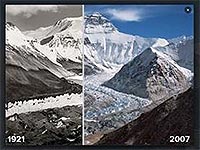Microsoft Research and the company’s IE team joined Pixel Lab, filmmaker David Breashears and his GlacierWorks foundation on the HTML5-powered, touch-enabled site Everest: Rivers of Ice. While obviously optimized for Internet Explorer 10 and Windows 8/RT tablets like Microsoft’s Surface, the site appears to work well enough on other browsers (I tried it with Chrome).
And it’s worth the visit.
Visitors can not only virtually explore the majestic mountain, they can see the devastating effects climate change is having on its glaciers. Microsoft’s Roger Capriotti wrote in a blog post what inspired explorer David Breashears and ultimately led to Everest: Rivers of Ice.
“In 1983 after climbing Everest, I met Sir Edmund Hilary for the first time, and started a life-long friendship. Over the years, as I talked to him about my climbs and the pursuits of the summit, he said to me ‘David, someday you will learn to turn your eyes from the summit and look into the valleys.’ It took many years for me to understand that message. Over the past seven years, my non-profit GlacierWorks, has undertaken fourteen expeditions to the Greater Himalaya in order to document changes to the region’s glaciers and share them with the world,” explains David Breashears, explorer and filmmaker. “I started GlacierWorks to bring attention to the change I was seeing in this region I care about. The glaciers of the Greater Himalaya contribute to the water supply of billions of people; what happens in this region has a global impact. I am very excited to launch this project and give millions of people the opportunity to understand these important changes and also to explore Everest and the Himalaya.”
Check out the Vanishing Glaciers section to see just how much the glaciers have deteriorated in less than a century. The changes are especially striking in the West Rongbuk Glacier panorama.
Behind the scenes, there’s some impressive tech at work. In a Microsoft Green Blog post, Josh Henretig provides a rundown of the innovations behind the slick site:
- Touch: Bringing to focus how a touch-friendly web makes experiences more natural for users on devices like tablets, Everest: Rivers of Ice leveraged Internet Explorer’s touch model to deliver very intuitive ways to explore the Everest region.
- Gigapixel Panorama Viewer: Internet Explorer used the multi-resolution HTML5-based panorama viewer from Bing, which renders perspective corrected panoramas containing billions of pixels.
- Rich Interactive Narrative (RIN): Developed by Microsoft Research, RIN is a presentation technology for building nonlinear, interactive and cinematic narratives that seamlessly stitch together various media – like the gigapixel panoramas, videos, terapixel online maps, traditional paginated documents, and data visualizations.
Check out Everest: Rivers of Ice here, whether or not you have a Surface in hand. For a preview, watch the YouTube video below:
Image credit: Microsoft/GlacierWorks


Leave a Reply